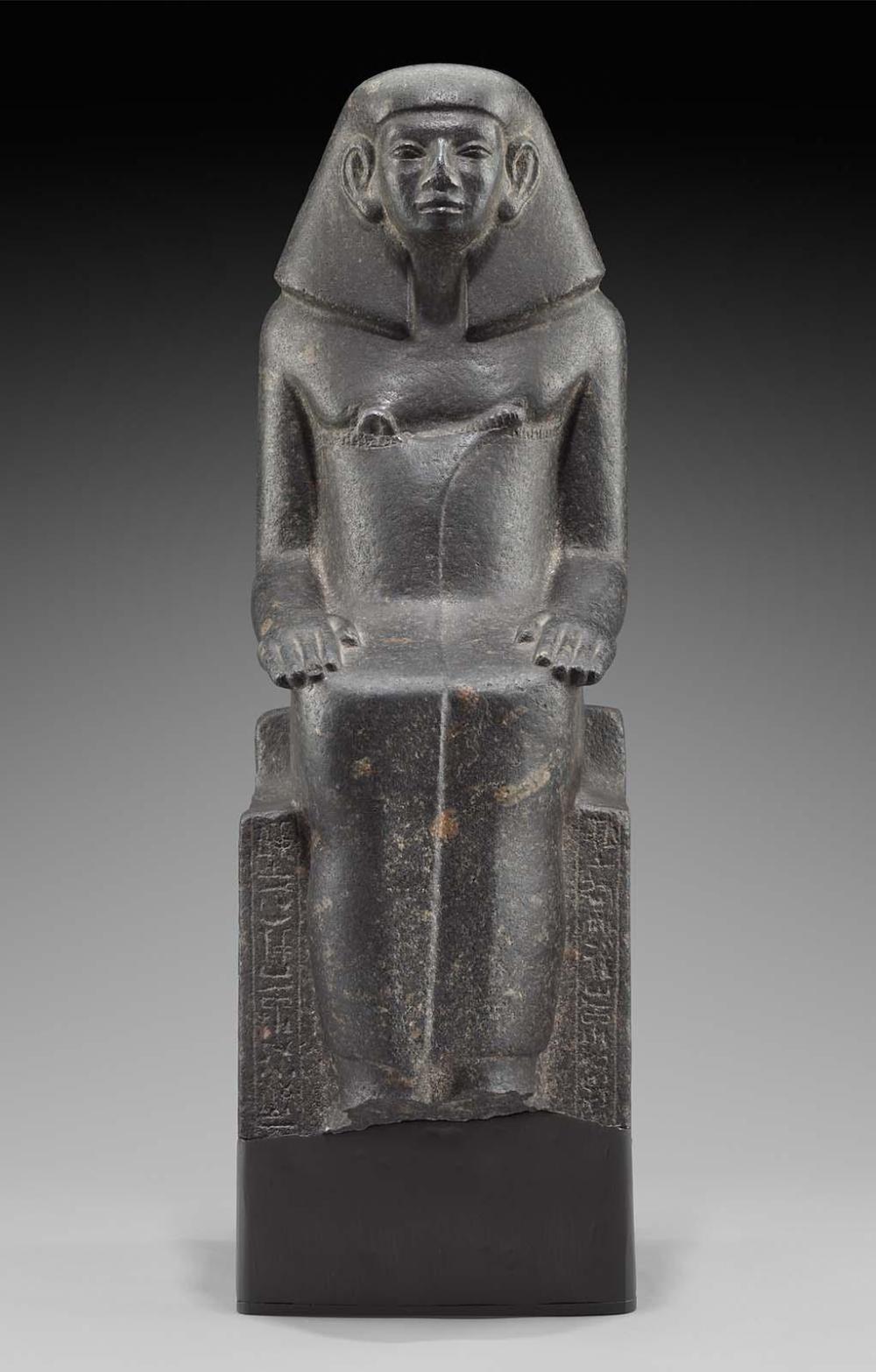Advanced Search
Statue of an anonymous official
Egyptian
Middle Kingdom, Dynasty 13
1783–1640 B.C.
Findspot: Sudan, Kerma, K III 4(1)
Medium/Technique
Granodiorite
Dimensions
Overall: 65 x 22 x 28.5 cm, 56.2 kg (25 9/16 x 8 11/16 x 11 1/4 in., 124 lb.)
Block (Two part-epoxy base with attaching aluminum plate): 17.8 x 22.2 x 20.3 cm (7 x 8 3/4 x 8 in.)
Block (Two part-epoxy base with attaching aluminum plate): 17.8 x 22.2 x 20.3 cm (7 x 8 3/4 x 8 in.)
Credit Line
Harvard University—Boston Museum of Fine Arts Expedition
Accession Number14.723
NOT ON VIEW
CollectionsAncient Egypt, Nubia and the Near East
ClassificationsSculpture
DescriptionSkillfully carved in hard, black granodiorite and polished to a high sheen, this statue of an unknown official exemplifies the high quality of nonroyal sculpture of the late Middle Kingdom. The features - a somber expression, high cheekbones, the ridge over the heavily lidded eyes, and enormous ears - do not reflect the man's actual appearance, but were inspired by those of the powerful kings Senwosret III and Amenemhat III of late Dynasty 12. The official portraiture of those kings not only was reflected in sculptures of their subjects during their own age, but also continued to influence artists for generations.
This individual sits upright with both palms open and resting flat on his lap. His long, thick wraparound kilt, tied across his chest with the pointed ends tucked in at the top, identifies him as a man of high rank. This garment, along with the heavy, shoulder-length head covering with points at the front, was fashionable male attire during the period from late Dynasty 12 through Dynasty 13. Statues of this type were made for use both in private tombs and as votive offerings in sanctuaries. Their relatively large numbers suggest a wider distribution of wealth and access to high status material among officials of the late Middle Kingdom.
Inscribed on the base of the seat is a prayer requesting offerings on behalf of the deceased from the gods Re and Anubis. Unfortunately, the text breaks off before giving the official's name, leaving his identity a mystery. Because the statue has much in common stylistically with examples from the sanctuary of the deified Old Kingdom official Heqaib at Elephantine, it is possible that it comes from that site. However, it was found along with numerous other Egyptian objects in the royal burial of a Nubian ruler at Kerma, hundreds of miles to the south of Egypt. Whether it reached Nubia as plunder or as a trade item during the unstable period at the end of the Middle Kingdom remains unknown.
This individual sits upright with both palms open and resting flat on his lap. His long, thick wraparound kilt, tied across his chest with the pointed ends tucked in at the top, identifies him as a man of high rank. This garment, along with the heavy, shoulder-length head covering with points at the front, was fashionable male attire during the period from late Dynasty 12 through Dynasty 13. Statues of this type were made for use both in private tombs and as votive offerings in sanctuaries. Their relatively large numbers suggest a wider distribution of wealth and access to high status material among officials of the late Middle Kingdom.
Inscribed on the base of the seat is a prayer requesting offerings on behalf of the deceased from the gods Re and Anubis. Unfortunately, the text breaks off before giving the official's name, leaving his identity a mystery. Because the statue has much in common stylistically with examples from the sanctuary of the deified Old Kingdom official Heqaib at Elephantine, it is possible that it comes from that site. However, it was found along with numerous other Egyptian objects in the royal burial of a Nubian ruler at Kerma, hundreds of miles to the south of Egypt. Whether it reached Nubia as plunder or as a trade item during the unstable period at the end of the Middle Kingdom remains unknown.
ProvenanceFound in Sudan, Kerma, K III 4(1), but originally from Egypt. 1914: excavated by the Harvard University-Boston Museum of Fine Arts Expedition; assigned to the MFA by the government of Sudan.



